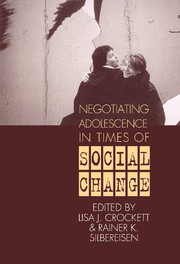Book contents
- Frontmatter
- Contents
- Contributors
- Preface
- 1 Social Change and Adolescent Development: Issues and Challenges
- Part I Models of Social Change Effects
- Part II Social Change and Adolescent Transitions
- 5 The Global Spread of Adolescent Culture
- 6 Social Change and the Sequencing of Developmental Transitions
- 7 German Unification and Adolescents' Developmental Timetables: Continuities and Discontinuities
- 8 Adolescents in Changing Social Structures: Bounded Agency in Life Course Perspective
- Part III Social Change and Adolescents' Social Contexts
- Part IV Implications of Social Change for Adolescent Health and Well-Being
- Part V Interventions: Promoting Healthy Development in Times of Social Change
- Endnotes
- Index
6 - Social Change and the Sequencing of Developmental Transitions
Published online by Cambridge University Press: 26 January 2010
- Frontmatter
- Contents
- Contributors
- Preface
- 1 Social Change and Adolescent Development: Issues and Challenges
- Part I Models of Social Change Effects
- Part II Social Change and Adolescent Transitions
- 5 The Global Spread of Adolescent Culture
- 6 Social Change and the Sequencing of Developmental Transitions
- 7 German Unification and Adolescents' Developmental Timetables: Continuities and Discontinuities
- 8 Adolescents in Changing Social Structures: Bounded Agency in Life Course Perspective
- Part III Social Change and Adolescents' Social Contexts
- Part IV Implications of Social Change for Adolescent Health and Well-Being
- Part V Interventions: Promoting Healthy Development in Times of Social Change
- Endnotes
- Index
Summary
Transitions in adolescence are part of developmental sequences reflecting those changes of state through which individuals pass on the route from childhood to adulthood. They contain biological, developmental, and the socially constructed components that determine the shape of the human life course in each society (Robins & Rutter, 1990; Chisholm, Kruger, & du Bois, 1995).
The physical maturational changes associated with puberty signal the beginning of adolescence, the acquisition of certain rights and responsibilities, and entry into adulthood. The process of developmental change includes the developmental tasks to be accomplished and the differentiation and commitment that accompany them in the construction of adult identity such as in the crystallization of gender identity (Erikson, 1968; Marcia, 1966). These are associated with the shifting focal concerns of adolescence: sexual relations, peer relations, and relations with parents (Coleman, 1974; Hendry, 1983), successful resolution of which is critical to adjustment to adult life. The change in focal concerns is paralleled in leisure life by the moves from family to single-sex peer group, to mixed group, to partner, parenting, and marriage (Hendry, 1983). Finally we come to the transitions that are most obviously socially defined. These include the transition from school to work, involving the changes in status from school student to trainee to adult worker with the accompanying shift in autonomy from dependent child to independent adult. Family formation may be formalized through the institution of marriage. Political participation will come through the right to vote. Contracts may be entered into and criminal responsibility shouldered. Such status changes are usually age based, as enshrined in legislation, and will vary between countries.
- Type
- Chapter
- Information
- Negotiating Adolescence in Times of Social Change , pp. 89 - 103Publisher: Cambridge University PressPrint publication year: 1999
- 2
- Cited by

